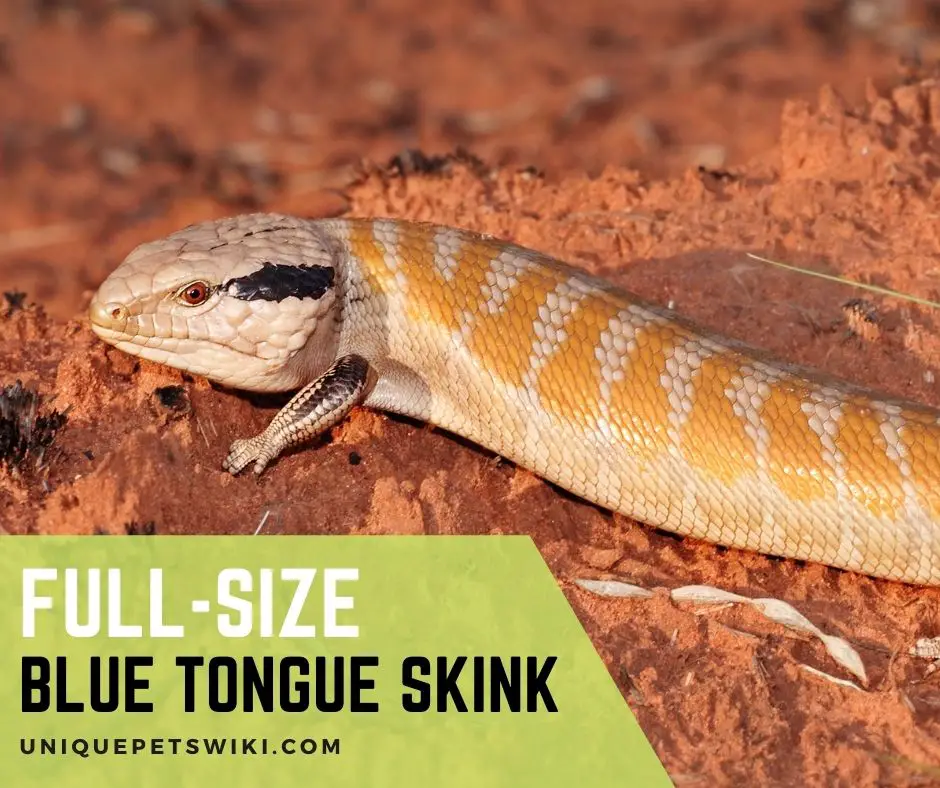Blue tongue skinks are among the most versatile pet reptiles in the pet trade, making them suitable pets for beginners and experienced hobbyists.
They originate from the deserts of Australia, Tasmania, and New Guinea. As a first-time owner, you may be wondering how big can this reptile be.
Blue tongue skinks can grow to around 18-22 inches long when they reach adulthood. Although they are big, they are suitable for everyone, even kids, as they can be easily handled.
In this article, we will help highlight everything you need to know about blue tongue skink size, from their size across each morph to factors that can affect their growth.
This article has been reviewed and approved by Dr. Dilber. Read more about our knowledge control process here.
Contents
Details of Full-Size Blue Tongue Skink for Owners
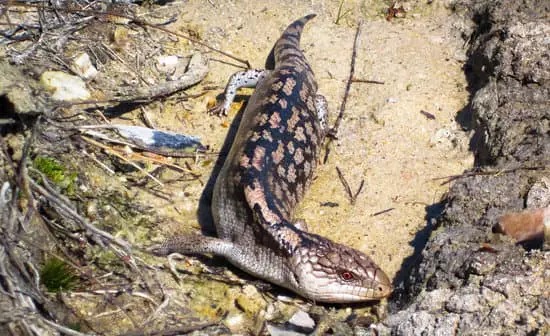
Blue tongue skinks are considered the largest type of blue tongue lizards that are kept as a pet.
They are usually 4 inches long at the hatchling stage and will take them 1-2 years to reach full maturity. Blue tongue skinks can grow to around 18-24 inches long when they reach full maturity.
The size of a blue tongue skink can be affected by their sex. Female blue tongue skinks tend to grow longer than males. Furthermore, the males usually appear slimmer than the female but weigh more.
The morph of a blue tongue skink also affects its size. There are some species of blue tongue skinks that can grow to around 17 inches long, while some reach full maturity at 14 inches.
Here is a table showing different blue tongue skink morphs, their size, lifespan, and appearance.
| Subspecies | Full Size (largest to smallest) | Lifespan | Appearance |
| Merauke Blue Tongue Skink | 30 inches | 15-20 years | Known for their long tails. They have distinct patterns along their body and have salmon-orange colored belly. There are also spots on their arms and legs. |
| Northern Blue Tongue Skink | 24 inches | 20 years | They have yellow or orange oval splotches on their sides with strong gray or beige forelegs. |
| Irian Jaya Blue Tongue Skink | 24 inches | Over 20 years | Has a dark brown body with a light peach or gold undertone |
| Blotched Blue Tongue Skink | 23.5 inches | 20-30 years | They have black bodies with yellow, red, or orange blotches on their body. |
| Classic Indonesian Blue Tongue Skink | 20 inches | 15-30 years | Known for the black markings on their head with solid black forelimbs. They are available in earthy yellow or greenish color sprinkling between bands |
| Kei Island Blue Tongue Skink | 20 inches | Over 30 years | Presence of a special freckled look extends to their head. |
| Eastern Blue Tongue Skinks | 19 inches | 20-30 years | Presence of bold black bands behind their eyes. They also have a less distinct banding along their body. |
| Halmahera Blue Tongue Skink | 18-24 inches | 15-20 years | They have a black and white or black pattern and have a pink belly. |
| Centralian Blue Tongue Skink | 18 inches | 15-20 years | They have short bodies with large heads and slender tails. They are usually pale brown to gray, and there are orange-brown bands along their body and tail. |
| Tanimbar Blue Tongue Skink | 15-17 inches | 20 years | They are available in strong silver, yellow, or gray colors. |
| Shingleback/Bobtail Skink | 13-17 inches | 10-15 years | Presence of armor-like bumpy scales with nearly black tongues. They are available in a wide range of colors, from deep brown to cream. |
| Western Blue Tongue Skink | 8-20 inches | Up to 30 years | They have short tails with bold black bands behind their eyes. Brown belly and there are thicker patterns along their body. |
| Adelaide Pygmy Blue Tongue Skinks | About 4 inches | 18 years | Presence of brown, gray, bronze, and white patterns and colors on their body. |
How Long Does It Take for A Blue Tongue Skink to Be Full-Grown?
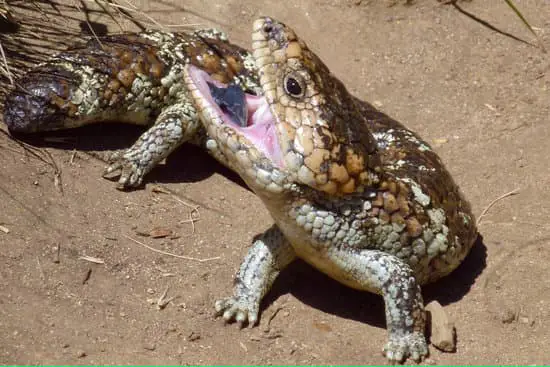
Baby blue tongue skinks grow an inch every week in the first 2-3 months as a baby.
The growth rate will then slow down continuously afterward as they will grow at around 0.4 inches in the 4-5 months.
At nine months the size of the blue tongue skink should be anywhere between 12 to 20 inches. The growth rate will also slow down even further at the juvenile stage.
Your blue tongue skink can grow around 1-2 inches a month during the juvenile stage. It will take the blue tongue skink 18-24 months to reach full maturity.
They usually grow to about 18-24 inches and will require at least 120 gallons of an enclosure to stay active and healthy.
Once blue tongue skinks reach 2-2.5 years old, they will stop growing based on their diet, living conditions, activity, and habits.
Also read:
- Juvenile Blue Tongue Skink: Size, Food & Identify Tip
- Baby And Juvenile Blue Tongue Skinks Care Guidelines
Factors That Affect Full-Size Blue Tongue Skink
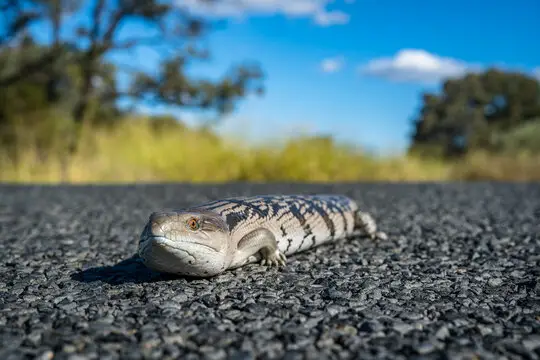
Several factors can affect blue tongue skink; some of them are stated below.
- Environment
- Genetics
- Sex
- Diet
- Disease
Environment
The environment you keep your blue tongue skinks will determine its size. For instance, if you keep your blue tongue skink in a tank with incorrect temperature, it can have a digestive issue. This can then lead to loss of appetite, which can then affect their growth rate.
It is necessary to maintain the correct temperature and humidity in the tank to promote the growth of blue tongue skink. For example, humidity in the enclosure should be 65% to prevent infections, and stress and enhance healthy growth.
Genetics
There are different blue tongue skinks morphs out there, and they all grow to a different size. This means the maximum size of an Adelaide Pygmy blue tongue skink can not be more than 4 inches.
However, some species of blue tongue skink like Merauke blue tongue skink can reach 30 inches long.
The size of a blue tongue skink depends on the genetic makeup of its parents. Some environmental factors during breeding influence the gene sequence and can cause mutations. So, the variation in the blue tongue size can also be due to genetic mutations and drifts.
Sex
The sex of a blue tongue skink can affect its size. Female blue tongue skinks are known to grow longer than males.
This means you should not expect two blue tongue skinks of different sex to grow at the same rate.
Diet
Blue tongue skinks need an ideal diet to stay happy and healthy like other pets. Blue tongue skinks can have stunted growth if you are feeding them with a poor diet, especially in the first six months.
This is why it is important that you feed your skink with a balanced nutritional diet.
Providing a good diet when a blue tongue skink is young and growing can promote good and healthy growth. So, focus on the diet of skink when it is a baby or at the juvenile stage and feed food rich in protein.
Disease
Blue tongue skinks may have stunted growth if they have an allergy or disease.
3 Tips To Care Full-Size Blue Tongue Skink
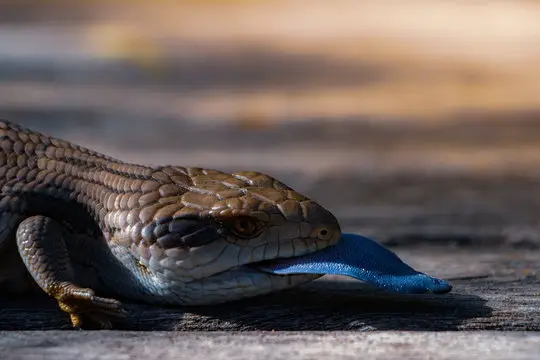
As a responsible owner, you will need to regularly care for your full-size blue tongue skink to help ensure they stay healthy and enjoy a happy life.
Some of the tips to help care for your full-size blue tongue skinks are stated below.
Ideal Habitat For Full-Size Blue Tongue Skink
Full-sized blue tongue skinks are large-sized lizards, and it is crucial that you provide a very large enclosure for them.
You can keep them in at least a 40-gallon enclosure, but it is best to provide a tank that is around 60 gallons or more to keep them comfortable.
It is also important that their tank is well ventilated, can retain heat, and the top is made of mesh.
You should also add logs, live plants, rocks, substrate, etc., to help mimic their natural environment and provide space where they can hide.
The temperature in their enclosure should be between 70-80F, while the basking area should be around 95-100F. The humidity in their enclosure should also be around 20-40%.
Also read:
- Best Blue tongue skink Enclosure For Building The Correct Habitat!
- Ultimate List: TOP 10 Best Blue Tongue Skink Substrate For Bedding
- The 8 Best Heaters For Blue Tongue Skinks To Create Perfect BTS Habitat
- TOP 19 Accessories for Your Blue Tongue Skink (Blue Tongue Skink Supplies)
Ideal Diet For Full-Size Blue Tongue Skink
Generally, blue tongue skinks are omnivorous creatures as they eat both live foods and plants.
It is recommended to feed adult blue tongue skinks with fruits and vegetables every other day. Your lizard will surely eat any vegetable or fruit; this includes turnips and collard greens.
You can also include live food like insects into their diet. However, this should be a few times a week.
Blue tongue skinks also need vitamin supplements in their diet to keep them healthy. You should also try to keep fresh water in a shallow bowl in their enclosure.
Also read: Blue Tongue Skink Diet Guide: Your Top Questions Answered (2020)
Zoo Med 3 Cans of Zoo Menu Blue Tongue Skin and Tegu Food, 6 Ounces each
- Zoo Menu
- Tegu and Monitor food
- 6 oz
- Zoo Med
- Pack of 3
Last update on 2022-12-29 / Affiliate links / Images from Amazon Product Advertising API
Pay Attention To The Behavior Of Full-Size Blue Tongue Skink
It is important that you understand your pet’s behavior if you want to keep them healthy and happy. This will help to easily detect when your pet is not happy or suffering from a disease.
Adult blue tongue skinks are solitary animals and will not feel lonely if kept alone.
They also love handling as this helps to make them friendly and recognize their owners. If not handled regularly, adult blue tongue skinks may become flighty and try to hide.
One of the behaviors of your skink that you can pay attention to is shedding. Adult blue tongue skinks are usually shed once in 2-3 months.
Although you don’t have to interfere in the shedding process, you should inspect your skink to determine if there are no stuck sheds around their toes, tail, ears, etc.
If you notice this, you will need to help them get it off their body.
You also need to pay attention to your skink’s behavior to help determine whether it is healthy or not. Some of the signs that your adult blue tongue skink is healthy are happy are:
- Has a healthy appetite
- Active and alert
- Hiding regularly
- Poops regularly
- Calm when handled
- Basking regularly
- Shedding regularly
Blue tongue skinks can grow up to a certain age and stop growing when they become adults. So, you will not notice how fast a blue tongue skink grows when it becomes adult.
However, your adult skink may not be healthy if you notice these signs
- Throwing up
- Not active
- There are secretions from the eyes, nose, or mouth
- Has lifted scales
- Has lumps on its back or tail
- Bones is softening
- Is not eating regularly, etc.
Once you notice any of these signs, you can try to take your skink to the vet for diagnosis.
Also read:
- Do Blue Tongue Skinks Like To Be Handled? #1 Secret You Didn’t Know
- Best Basking Spot for a Blue Tongue Skink
How Much Do Full-Size Blue Tongue Skink Cost
Adult blue tongue skinks usually cost more than a baby or juvenile blue tongue skinks. You can buy a common blue tongue skink for $150 or more.
However, a rare blue tongue skink can cost you about $5000 or more.
The price for a blue tongue skink also depends on the sex of the lizard. You will pay 20-30% higher when buying a female blue tongue skink than a male BTS.
The maintenance costs for keeping a blue tongue skink are about $40 per month for a lizard.
It is best to buy a blue tongue skink from a reputable breeder. However, you can also get them from pet stores and reptile expos.
As a first-time keeper, it is best to buy baby blue tongue skinks instead of full-size skinks because to help ensure you can easily handle them.
Also read:
- How Much Do Blue Tongue Skinks Cost? 10 Morphs’ Prices + Accessories Costs
- Buy Blue Tongue Skink – Cost And 5 Tips To Choose A Good Healthy Skink
Zoo Med Cork Bark Round for terrariums
- Safe for all reptiles, amphibians, and arachnids (i.e. tarantulas).
- Can be easily cut to any desired length or shape
- All natural green" product"
Last update on 2022-12-29 / Affiliate links / Images from Amazon Product Advertising API
Wrapping Up
Blue tongue skinks are big-sized lizards and can grow to around 20 inches or more when they reach full maturity.
They will make a suitable pet for the family if you have enough space and provide the diet requirements to keep them healthy.
